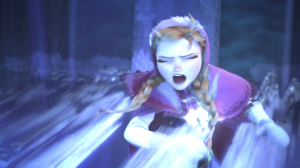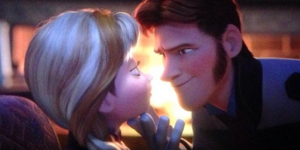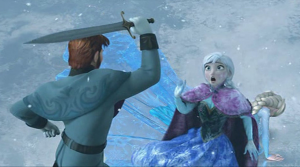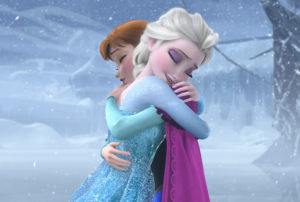By Amanda Reisman
Is all love the same? No! Bear with me, and I will explain how love varies in depth and meaning. I don’t mean that our love of Harry Potter differs from our love of food. I’m talking about people. We all love in different ways. Some people love more, and some love less. Some try to hide their love, and some love too much. How do we learn to control the love that seems to consume and conquer us? We become subjects to whatever our hearts desire. Who we love and what we love becomes a part of who we are. We perceive this love in its many different forms. There is forbidden love, idolized love, fake love, and real love. Where do we draw the line? Is the love we see in media real? Can we tell if our love is true?
The culture we consume has generally portrayed love as the ultimate goal. This creates a real world desire among people to find their “soulmates.” I put the word soulmates in quotation marks to emphasize how the idea of finding our one true love has been produced and implemented into our culture through media. The belief that we each have a soulmate, a person who we are designed to be with, is quite controversial. How can we know who that is? What if we haven’t met that person? Regardless, media has instilled a concept of finding our own Prince Charming. Children watch movies where princes and princesses fall in love and live happily ever after. The prince is idolized and made out to be the ideal soulmate. The princesses sing song after song about finding their prince. They become entranced by just the thought of seeing their lover again. The practicality of these movies is absurd. Frozen, the first break in the seemingly never-ending stream of Disney princess movies, has stemmed away from this culturally produced notion of love.
Frozen (2013) is centered around a princess named Anna whose sister, Elsa, has ice powers. Her sister accidentally freezes Anna’s heart, and only an “act of true love to thaw her frozen heart.”

Elsa accidentally freezes Anna’s heart
https://www.youtube.com/watch?v=KqDE95-gP6M
The movie initially revolves around Anna’s mission to find Hans, a prince who she met and immediately fell in love with. She was so focused on finding “the one” that she declares Hans to be her soulmate immediately after she meets him. Needing love to save her, Anna journeys to find him for an act of true love. This act of true love is immediately perceived as a true love’s kiss. A true love’s kiss immediately references another Disney movie: Sleeping Beauty. Sleeping Beauty waits for Prince Phillip’s kiss to save her from her deep sleep. The idea of a true love’s kiss solidifies Disney’s focus on how only real, romantic love can save us from evil. This love is seemingly the only form of protection from evil. The beginning of Frozen seems to fall right in line with Sleeping Beauty. The search for love as the savior from death is common in both of these movies. True love’s kiss wakes up Sleeping Beauty; however, Anna, of Frozen, realizes she has been blinded and tricked by her desires.
You are now probably wondering why I explained the similarities between an old classic Disney princess movie and Frozen. Disney, by creating Frozen, is ironically mocking their previous movies. Now before you immediately disregard my assertion, just listen to what I have to say. After Anna finally finds Hans, she is dying and in need of an act of true love. Believing Hans is her knight in shining armor, Anna asks for a true love’s kiss. He rejects her attempt and reveals how he only pretended to fall in love with her to become the next King of Arendelle. Her obsession with finding her one true love resulted in her thinking that Hans was the one. What she thought was true love couldn’t save her. Her infatuation deceived her. There was seemingly no happily ever after.

Hans reveals his true intentions
https://www.youtube.com/watch?v=KqDE95-gP6M
Anna has been tricked! What? Disney, who? The prince and princess are supposed to fall in love and live happily ever after. What happened? This unprecedented twist of events is unlike any Disney princess movie ever made. The man has deceived the woman for power! Now that definitely couldn’t be Disney!
To continue my thoughts on the divide between Frozen and previous Disney movies, I would like to compare the opposing plots from Frozen and Cinderella (1950). In the movie Cinderella, Prince Charming, after dancing with Cinderella at the ball, needs to find her again. He believes he has found his true love and is relentless in finding her. Eventually, they reconnect and live happily ever after. On the other hand, Frozen’s Anna is fighting to find Hans! This is the first Disney movie where the girl is desperately trying to find the boy. She feels that she “needs” to find him to survive. Despite proving that Disney is mocking their previous work with this idea of needing a man to “survive,” the beginning of Frozen draws attention to this role reversal, which is just one difference between these two movies. Cinderella follows right along Disney’s classic princess movie mold. The girl meets the boy, and they fall in love. Some evil thing happens that attempts to separate them, but they find each other again and live happily ever after. This structure is mocked by Frozen. The girl meets the boy, and the girl thinks she found true love. Some evil thing happens, and the boy leaves the girl to die in order to take over her kingdom. The change in plot makes a joke out of every classic Disney princess movie by showing how completely unrealistic and farfetched those movies actually are. Love at first sight is actually not a realistic notion! Not everyone is who they say they are or who we want them to be!
After Hans abandons Anna, she manages to find her sister. Hans, in order to become King, needs both Anna and Elsa to die. However, Anna steps in front of Hans’s sword to save Elsa and freezes there. By sacrificing herself, she performs an act of true love and suddenly unfreezes and returns to her normal health.

Anna sacrificing herself for her sister
https://www.youtube.com/watch?v=b2xn0jDmiTw
Their sisterly love saves them. Anna is cured, and Elsa learns to control her powers through love. Family is the most important part of our lives! The love we feel for our family is insurmountable. This unbreakable bond will protect us from everything! Frozen broke away from mainstream Disney princess movies by changing its view on powerful love. Previously, the love between a prince and a princess was enough to stop evil. In Frozen, the love between two sisters is stronger than any relationship or any impending danger. Only “love can thaw a frozen heart.” The notion that “love thaws” is crucial to the ideals present in Frozen. Love defrosts; it unfreezes; it warms. Love removes the cold. Only true love can save us! Real love can be found, where Disney has never before represented it, within our families.
This stress on familial love instead of romantic love was a significant change for Disney to make. Their target audience being children is vital to how they construct their movies. Kids watch these movies and immediately associate with/desire to be the princesses. Previous Disney princess movies have instilled ideas of soulmates, “Prince Charmings,” and true love into the minds of 5 year-olds. That’s ridiculous! We should be teaching kids about family, loving your family, and putting your family above all else. Frozen is the perfect demonstration of familial values, and Anna is the greatest example of bravery and selflessness in all of the Disney princess movies.
Frozen is an unprecedented creation where love triumphs all and combats evil. There are some movie critics who would disagree with the facts I have stated about Frozen. Elizabeth Weitzman, of the New York Daily News, claims that there is still something missing from Frozen. “What’s crucially missing, however, is a hissable villain” (Weitzman, Elizabeth, Frozen, Movie Review). I’m sorry…what? A “hissable villain!” Why would we create movies geared for kids where powerful villains are the enemy? These kids learn to hate the Evil Queen or Maleficent without truly understanding why these characters are seemingly inherently evil. The classic Disney movies provide no solutions to help cure these villains of their evil intentions. The prince and princess simple defeat their villains. However, Frozen has no specific villain. Hans is definitely a despicable character, but as a viewer, I can understand why he was so evil. He wanted to become King! He is ultimately defeated by Elsa and Anna’s realization that love thaws! No matter what evil comes about, their unwavering love for each other will win at all costs. In classic Disney princess movies, there is no such revelation. There is only romantic love defeating evil!
Other critics have stated that Frozen is just another Disney love story. On http://www.imdb.com/title/tt2294629/reviews, a critic under the username rford191 had a particularly interesting and astonishing review of Frozen. This reviewer said one con of Frozen was “plot idiocy…If fear is the enemy, why do you seclude/terrorize the princess with insecurities? How/why does “love” recall winter? Didn’t Elsa love her family all along? Wasn’t there “love” present all this time? There was zero explanation for how this worked. Just “love”” (rford191, “An Astonishing Disappointment” IMDb Reviews and Ratings for Frozen). This critic may be right to some extent, but, until the end of Frozen, there was never a direct declaration of love or any act displaying sisterly love. Anna, despite her sister’s neglect, sacrificed herself. This act of pure love cannot be surpassed by anything else. The ultimate declaration of love is putting someone else’s life ahead of your own; sacrifice. In the video clip that I added, Anna clearly chose to save her sister over herself by running away from Kristoff to stop Hans’s sword. Additionally, Anna’s growth as a character is crucial to the plot. Her flaws are transformed into bravery. She overcomes her past with her sister’s neglect and the loss of her parents to realize what she truly wants and who she wants to be with. She discovers who the important people in life are and who she can trust and count on. Anna does have many weaknesses. She is tricked and deceived because of her willingness and hopefulness in the world of love. She is the only Disney character who has these prevalent insecurities. Anna is not perfect, which separates her from all the idolized princesses of previous movies. Ultimately, she overcomes these imperfections through courage and sisterly love. The love she feels for her sister was always there, but she needed to be brave in order to save Elsa (thus displaying her love). Love, a warm feeling, is ultimately what recalls the eternal winter. This is a slightly abstract idea, but that’s just Disney! It’s the underlying messages sent by the presence of warmth and sisterly love that are important in differentiating Frozen from previous Disney princess movies.
Many critics have claimed that Anna is just another princess who falls in love and lives happily ever after. I will admit that part of that statement is true. She finds love with Kristoff, and we are expected to believe that they will live happily ever after. However, she doesn’t end up with the prince, the first boy she meets! Kristoff, the ice man, is from a different world.

He comes from no wealth or power, and she actually takes the time to get to know him. She fell in love over a period of time rather than just instantly! This also distances her from almost every other Disney princess who falls in love with the prince who saves her. Additionally, Kristoff doesn’t save Ana! She actually saves herself her willingness to protect her sister. It is important to note that Anna is the hero of her own story. This is the first time the princess has ever been the hero in any Disney princess movie! Anna overcomes her previous family issues, her internal struggles, and her obstacles with love in order to save Elsa and help recall the eternal winter.
Do you see it now? Frozen has provided us with a deviation from the never-ending stream of perfect princesses and princes riding off into the sunset. We have struggles of love, power, and trickery! The main character is flawed, but she surmounts her imperfections in order to survive. Frozen’s value of sisterly love in order to stop evil differs from previous classics in which romantic love is the ultimate goal.

These plot twists are new for Disney. They have thrown the cookie-cutter model out the window, thus proving why this movie was so successful. Everything about this movie was unexpected from Hans’s duplicity to how sisterly love saves Anna. It provides the viewers with a new take on love, deception, and family! Disney has diverged from its previous mold of romantic love, idolized princesses, and heroic princes.
To finally solidify all of my points, the break between Frozen and classic Disney movies are a perfect example of distinction within a similar realm of culture. Disney has been producing these princess movies for decades, but “for the first time in forever” they have provided a counterculture. This counterculture outright rejects the uniformity of mass produced culture. Adorno is a critic of cultural theory, and he believes that when culture is mass-produced (for example, Disney movies are mass produced) it is in danger of becoming the same. Adorno’s word of choice (“sameness”) is a very close-minded view of culture and is a very ambiguous description. I have spent this essay explaining to you the visible break between classic Disney princess movies and Frozen. This division is clearly not “sameness.” It is a totally different new realm of culture that has stemmed from a mass produced system. Adorno claims that despite appearing different, culture all lands in the same place. To counter Adorno’s view on the sameness of mass produced culture, Frozen is the perfect break from previous Disney movies by exemplifying sisterly love, strong female characters who overcome their flaws, and women becoming the unexpected heroines of their own stories.
Images from Google, and Video clips from Youtube.